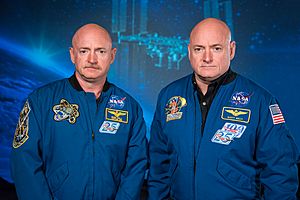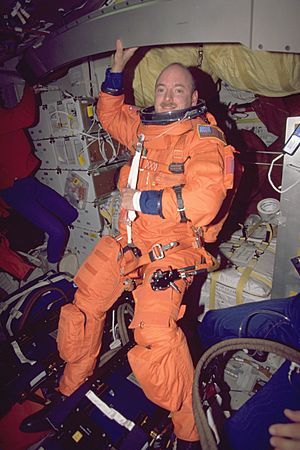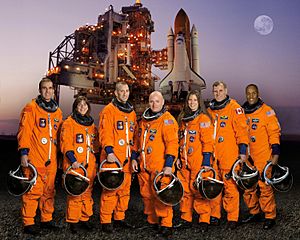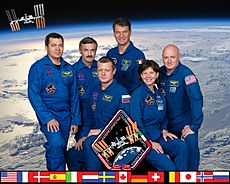Scott Kelly (astronaut) facts for kids
Quick facts for kids
Scott Kelly
|
|
|---|---|
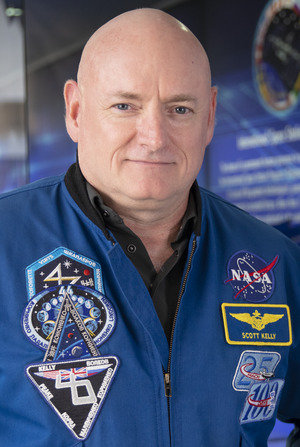
Kelly at the Johnson Space Center in 2019
|
|
| Born |
Scott Joseph Kelly
February 21, 1964 Orange, New Jersey, U.S.
|
| Education |
|
| Spouse(s) |
Leslie Yandell
(m. 1992; div. 2009)Amiko Kauderer
(m. 2018) |
| Children | 2 |
| Relatives | Mark Kelly (twin brother) |
| Space career | |
| Rank | Captain, USN |
|
Time in space
|
520d |
| Selection | NASA Group 16 (1996) |
|
Total EVAs
|
3 |
|
Total EVA time
|
18h 20m |
| Missions | STS-103 STS-118 Soyuz TMA-01M (Expedition 25/26) Soyuz TMA-16M/Soyuz TMA-18M (Expedition 43/44/45/46, ISS year-long mission) |
|
Mission insignia
|
|
| Retirement | April 1, 2016 |
Scott Joseph Kelly (born February 21, 1964) is an American engineer and a retired astronaut. He was also a naval aviator, which means he flew planes for the Navy.
Scott Kelly has flown into space four times. He even commanded the International Space Station (ISS) during three different missions.
His first trip to space was in December 1999 as a pilot on the Space Shuttle Discovery. This mission, called STS-103, helped fix the Hubble Space Telescope. It lasted for about eight days.
In August 2007, Kelly commanded his second space mission, STS-118. This 12-day Space Shuttle flight went to the ISS. His third spaceflight was as a crew member on Expedition 25 and Expedition 26 aboard the ISS. He arrived in October 2010 and later became the commander of the station in November 2010.
In November 2012, Scott Kelly and Russian cosmonaut Mikhail Kornienko were chosen for a special year-long mission on the ISS. They launched in March 2015 and stayed on the station for several expeditions. Their long mission ended in March 2016.
Scott Kelly retired from NASA on April 1, 2016. His identical twin brother, Mark Kelly, is also a retired astronaut and is currently a U.S. senator for Arizona.
Contents
Early Life and Education
Scott Kelly and his identical twin brother, Mark, were born on February 21, 1964, in Orange, New Jersey. Their parents, Patricia and Richard Kelly, both worked as police officers.
The Kelly brothers grew up in West Orange and graduated from West Orange Mountain High School in 1982. While in high school, Scott also worked as an emergency medical technician.
After high school, Scott started college at the University of Maryland, Baltimore County. During his first year, he read a book called The Right Stuff by Tom Wolfe. This book inspired him to want a career flying planes for the Navy.
He then transferred to State University of New York Maritime College. He received a scholarship from the Naval Reserve Officers Training Corps (Navy ROTC). He sailed on the training ship Empire State V during his summers. In 1987, he earned a Bachelor of Engineering degree in electrical engineering. Later, he earned a Master of Science degree in aviation systems from the University of Tennessee.
After college, Scott Kelly became an ensign in the United States Navy. He went to flight school at NAS Pensacola and learned to fly propeller planes. He was then chosen to fly jets.
In 1988, he trained on jet planes like the T-2 Buckeye and the A-4 Skyhawk in Texas. He became a naval aviator in 1989 and was assigned to fly the F-14 Tomcat fighter jet. He deployed to the North Atlantic and Persian Gulf on the aircraft carrier USS Dwight D. Eisenhower.
In 1993, Kelly was chosen to attend the U.S. Naval Test Pilot School in Naval Air Station Patuxent River, Maryland. His brother Mark and other future astronauts were also in his class. He graduated in 1994. One of his jobs was to improve the F-14's flight system after a crash. He was the first pilot to fly the F-14 with this new digital system.
Scott Kelly became a captain in the U.S. Navy. He retired from active duty on June 19, 2012, after 25 years. He had flown over 8,000 hours in more than 40 different aircraft. He also completed over 250 landings on aircraft carriers.
NASA Career
In 1995, Scott Kelly and his brother Mark applied to NASA to become astronauts. In April 1996, they were both selected. They were the first relatives ever chosen as astronauts at the same time.
In July 1996, Kelly moved to Houston and began training at the Johnson Space Center. After his training, he worked on the warning system for the International Space Station.
After his first space flight, Kelly worked as NASA's director of operations in Star City, Russia. He also served as a backup crew member for other ISS missions. After the Space Shuttle Columbia disaster, Kelly helped coordinate searches for debris. He also led the Astronaut Office Space Station Branch.
In September 2002, Kelly commanded the NEEMO 4 mission. This mission took place in the Aquarius underwater laboratory, off the coast of Key Largo. The crew spent five days underwater. This was like a space mission simulation, helping them practice working in extreme conditions. In April 2005, Kelly was also part of the three-day NEEMO 8 mission.
First Space Mission: STS-103
In March 1999, Kelly was assigned as a pilot for STS-103 on the Space Shuttle Discovery. The mission's goal was to install new instruments and upgrade systems on the Hubble Space Telescope (HST).
Discovery launched on December 19, 1999. The astronauts performed three spacewalks to replace parts and install new equipment on the HST. On December 25, 1999, the crew celebrated Christmas in space. After 119 orbits, Discovery landed on December 27, 1999.
Second Space Mission: STS-118
After his first mission, Kelly was assigned as commander of STS-118 on the Space Shuttle Endeavour. This mission was delayed until August 2007.
STS-118 launched on August 8, 2007. During launch, foam hit the orbiter, but the damage was not dangerous. Endeavour successfully docked with the ISS on August 10. The crew added a new part to the ISS and a platform for spare parts. The mission was extended to test a new system for power. Four spacewalks were completed. The mission ended a day early due to a hurricane. Endeavour landed on August 21, 2007, after 12 days in space.
Third Space Mission: Expeditions 25 and 26
In late 2007, Kelly was assigned to Expedition 25 and Expedition 26 on the ISS. He launched aboard Soyuz TMA-01M from Kazakhstan on October 7, 2010. He joined the Expedition 25 crew as a flight engineer.
During his time on the ISS, the crew worked on about 115 science experiments. These included testing a water-recycling machine and researching how vegetables grow in space. Cosmonauts also performed a spacewalk to install equipment. On November 25, 2010, Kelly took over as commander of the station for Expedition 26.
In December 2010, new crew members arrived on Soyuz TMA-20. The Space Shuttle Discovery also visited the station in February 2011 for its final flight.
While Kelly was on the ISS, his sister-in-law, Congresswoman Gabby Giffords, was shot in January 2011. Kelly returned to Earth on March 16, 2011. His brother Mark, also an astronaut, commanded the final flight of Endeavour in May 2011.
Year-Long Mission: Expeditions 43–46
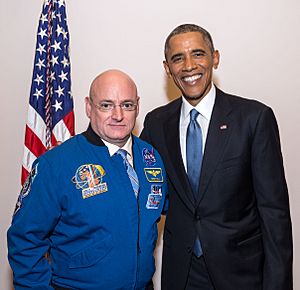
NASA planned a year-long mission on the ISS to learn more about how space affects the human body. In November 2012, Scott Kelly was chosen for this mission, along with cosmonaut Mikhail Kornienko.
Kelly, Kornienko, and Gennady Padalka launched aboard Soyuz TMA-16M from Kazakhstan on March 27, 2015. They docked with the ISS and joined the Expedition 43 crew. They performed many science experiments, including studying how fluids shift in their bodies and collecting blood and urine samples.
During this long mission, the ISS received supplies from different spacecraft. There were also some supply mission failures. New crew members arrived on Soyuz TMA-17M and Soyuz TMA-18M. Kelly took command of the station for Expedition 45 on September 11, 2015.
Kelly performed two spacewalks during Expedition 45. He worked on the Canada Arm 2 and installed cables for new docking adapters. Expedition 46 began in December 2015.
On December 15, 2015, new flight engineers joined Expedition 46. Kelly and another astronaut performed an unscheduled spacewalk on December 21, 2015, to fix a problem with a rail car on the station. On January 8, 2016, Kelly appeared on The Tonight Show Starring Jimmy Fallon from space.
On March 1, 2016, Kelly transferred command of the ISS and returned to Earth with Kornienko and Volkov aboard Soyuz TMA-18M. They landed in Kazakhstan.
During his year in space, Kelly was part of a special study. His identical twin brother, Mark, stayed on Earth as a comparison. Scientists studied both brothers to see how spaceflight changed Scott's body. After returning, Scott's body adapted back to gravity. Genetic tests showed changes in his genes and an increase in the length of his telomeres (parts of chromosomes).
After NASA
Scott Kelly announced his retirement from NASA on March 12, 2016. His retirement became official on April 1, 2016.
In November 2016, Kelly was named a United Nations Champion for Space. He helps raise awareness about space activities. In November 2017, he released a book about his year in space called Endurance: A Year in Space, a Lifetime of Discovery.
In June 2018, Kelly spoke at a UN conference. He shared his belief that "if we can dream it, we can do it...and most importantly, if we work as a team, because teamwork makes the dream work. The sky is not the limit."
On October 27, 2022, Kelly became an ambassador for the UNITED24 project. He helps raise money for medical aid, specifically for C-class ambulances in Ukraine. Many ambulances were destroyed during the Russian-Ukrainian war.
Personal Life
Scott Kelly married Leslie Yandell on April 25, 1992. They had two children together. They divorced in 2010. In July 2018, Kelly married Amiko Kauderer, who works as a public affairs officer for NASA. His sister-in-law is Gabby Giffords, a former congresswoman.
In 2007, Kelly received medical treatment for a health issue. His brother Mark also received similar treatment successfully.
Awards and Honors
Scott Kelly has received many awards and honors, including:
 |
United States Naval Astronaut Badge |
| Ribbon | Description |
| Defense Superior Service Medal | |
| Legion of Merit | |
| Distinguished Flying Cross | |
| Navy and Marine Corps Commendation Medal | |
| Navy Achievement Medal | |
| Navy Unit Commendation | |
| NASA Distinguished Service Medal | |
| NASA Exceptional Service Medal | |
| NASA Outstanding Leadership Medal | |
| NASA Space Flight Medal (three awards) | |
| National Defense Service Medal (two awards) | |
| Southwest Asia Service Medal | |
| Navy Sea Service Deployment Ribbon | |
| Kuwait Liberation Medal (Saudi Arabia) | |
| Kuwait Liberation Medal (Kuwait) | |
| Medal "For Merit in Space Exploration" (Russian Federation) |
Kelly received an honorary Korolev Diploma in 1999 and an Honorary Doctorate of Science degree in 2008. He was featured on the cover of Time magazine in December 2014. In 2015, he was named one of Time magazine's 100 Most Influential People.
He is a member of the Society of Experimental Test Pilots and the Association of Space Explorers.
On March 9, 2022, Scott Kelly tweeted that he would return his Russian Medal "For Merit in Space Exploration." He said he would mail it to the Russian embassy in Washington.
See also
 In Spanish: Scott Kelly (astronauta) para niños
In Spanish: Scott Kelly (astronauta) para niños
- Ten longest human space flights
- A Beautiful Planet – an IMAX documentary film featuring Kelly and other ISS astronauts


